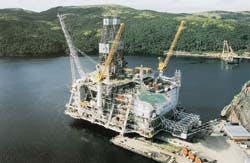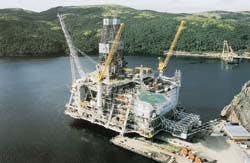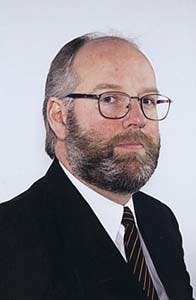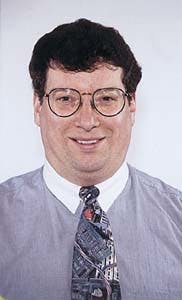Tor Stavnes
Fabcon Canada Inc.
Newfoundland, CanadaAlan C. Kearley
Hibernia Management & Development Co.
St. John's, Newfl.
Completed topsides, drilling, and production facilites, were at the assembly pier at Bull Arm prior to being moved to the Hibernia field.The extensive and detailed documentation required for operating the Hibernia platform, offshore Newfoundland, will largely be in an electric form.
Instead of depending on paper, Hibernia Management & Development Co. (HMDC) has implemented a state-of-the-art technical document management system (TDMS), which catalogs, searches, retrieves, assembles, and distributes electronic documentation on the platform and onshore.
Using software developed by Interleaf Inc., the system handles the technical information required to support the safe and efficient operation of the platform.
Rather than placing hardcopies in a central library, which would impede access, the TDMS gives Hibernia's workers instant availability at the point of use.
Engineering and fabrication drawings, operating system manuals, vendor manuals, material safety data sheets, procedures, and change control documents are all available in seconds from any PC on the platform.
Hibernia
The Hibernia platform is being installed about 250 miles off the coast of Newfoundland, in the icy, turbulent waters of the North Atlantic. The platform will be the largest offshore oil production platform in North America. Project costs are estimated at $5 billion (Canadian).
The platform is owned and operated by HMDC, a partnership of Mobil Oil Canada Properties (33.125%), Chevron Canada Resources (26.875%), Petro-Canada Hibernia Partnership (20%), Canada Hibernia Holding Corp. (8.5%), Norsk Hydro AS (5%), and Murphy Atlantic Offshore Oil Co.
Over its life, the platform is expected to produce about 600 million bbl of oil from sandstones at a depth of about 12,000 ft.
The platform will sit on the ocean floor in 260 ft of water and is designed to weather the potential impact of a 6 million-ton iceberg.
The 10,000-sq m platform weighs 1.2 million tons, contains miles of flow lines, accommodates 280 workers, and uses enough power to light a town of 40,000 people.
It is designed to produce as much as 125,000 bo/d.
Electronic documentation
Providing technical documentation purely in electronic form has some obvious benefits such as less space and quicker updating and retrieval. However, finding the right information when it is needed, and providing the correct format from the many types of documents involved, is challenging.
Source documentation comes in many shapes, sizes, and formats. System manuals may originate in an electronic publishing format, E-size engineering drawings from a CAD system, or vendor manuals. Data sheets may only be available in hardcopy, and other general documentation may exist in a word processing format.
Yet, when one is out on the North Atlantic there is a need for documented information that is quickly and easily available. There is not time to worry about whether that information is on a CAD drawing or in a word processing file.
What counts is getting the right information regardless of format.
Paper/online transition
Document management specialists from HMDC and Interleaf developed a conversion methodology for the project to retain visual compatibility with the original documentation, while capturing the content of each page for full-text indexing.
Paper documents were scanned and broken into two separate images: one optimized for viewing and the other optimized for optical character recognition (OCR).
Text produced from the OCR process was then fed into the Interleaf indexing system.
Documents originating in electronic format are converted using automated processes. Engineering drawings originating in Intergraph MicroStation format are converted into Postscript and then filtered into Interleaf WorldView.
This method captures all the text from the drawings, feeding it to the indexing engine, and produces final electronic viewing images that are 100% visually compatible with the originals.
Most of the text documents are in Microsoft Word. In this case, templates inside Word are created to automate the filtering into Interleaf 6 format.
Using a custom software application, all the converted documentation is then batch-loaded into an onshore document repository, a set of interrelated subsystems based on Interleaf's RDM document manager.
The repository provides library management with change control and workflow capabilities, allowing critical technical information to be shared among individuals or groups.
Using this document management technology, HMDC can continually update the repository with new and revised documentation to ensure that only the most current approved version is available for viewing.
In fact, when only some pages in a manual change, there is no need for converting and reloading the entire manual. Each page of every document is indexed and published electronically into a collection, or book, using a software product from Interleaf called WorldView Press.
In this way, any single page from among the thousands in the repository can be changed in its native format, re-entered into the repository, and automatically placed back into the appropriate collection in the correct sequence.
Instant access
Of course, from a user's perspective, the most important aspect of TDMS is the quick and easy retrievability of needed information. To achieve this goal, HMDC plans to place PCs at the point of use, in strategic locations directly in the midst of the production equipment out on the platform.
Document collections from the onshore repository are published to the offshore PCs, which are connected via a local area network (LAN). This approach ensures that the TDMS is always within reach.
Equally important, users can find what they need with the PCs thanks to graphical navigation tools, a full-text search capability, and hyperlinked tables of contents.
Using a graphical icon bar developed with Visual Basic 4.0, a user simply clicks on the PC screen to bring up the TDMS main menu. From there, the user has access to all the documentation in the system.
It is a reader-driven interface, so that the user can choose the preferred method for locating information-either by scanning the tables of contents of various collections or by queries that search across all the text in the system.
For example, when performing routine maintenance, the user would first consult the operation plan, an umbrella document that provides step-by-step guidelines for the platform operations. This document, in turn, refers to more specific documentation on the individual process systems in use.
More than 100 systems are on board the platform, many with their own operating manuals. These manuals will then refer to other detailed documentation, such as equipment vendor manuals, engineering diagrams, and material safety data sheets.
By simply clicking on a referenced document, the TDMS takes the user to that document, which is presented on screen in the correct format. The user can read through the material sequentially from page to page.
Alternatively, if users are troubleshooting a problem of an unknown origin, they can use a query interface to search for the appropriate documentation that addresses the issue.
By entering a few key words that describe the problem, they can search across all the documentation, including text and graphics, to identify relevant manuals, engineering drawings, technical notes, or any piece of information that may hold a clue. Again, hyperlinks expedite the research process.
Equipment details, such as piping and instrumentation diagrams, are essential for effective equipment maintenance and to accurately resolve problems.
Engineering drawings, however, present a special challenge. In the document repository, there are over 500 diagrams, all dynamically and logically linked with each other. Rather than requiring a user to retrieve multiple documents to trace a flow, the TDMS allows users to move smoothly from one diagram to another, following a flow throughout the platform without interrupting their train of thought.
Long-term value
In developing TDMS, HMDC focused on the needs of the users first, then approached the system design to meet those needs. An extensive analysis of all the project's mission-critical documents was conducted to determine levels of importance, frequency of use, revision cycles, and typical usage patterns.
This led to design of the integrated document control and change control system, to ensure that the rest of the TDMS system supported real-world requirements.
The document control system provides for the necessary audit trail, traceability, and validation. After all, everyone on the platform depends on fast, easy access to accurate technical documents to safely and effectively operate the high-technology equipment used on Hibernia.
Maximizing the value of that equipment was also a major objective. The capital investments for a project of this size are huge. The TDMS will support the ongoing maintenance of these complex systems to ensure they perform at peak operating efficiency, improving productivity in the short-term, and extending the life of the equipment in the long-term.
Mission-critical needs
Hibernia's technical document management system is a mission-critical element of this sophisticated platform. In fact, the TDMS is one of the systems being used by HMDC to obtain certification from the Canada Newfoundland Offshore Petroleum Board, an essential milestone for Hibernia to begin operations.
Although paper manuals could provide the necessary information, only an electronic system such as the TDMS could deliver that information to the point of use in seconds. This eliminates time-consuming trips to a central library and painstaking searches through hardcopy manuals. Moreover, only an electronic system can provide instant hyperlinks to all relevant documents and diagrams, which improves the thoroughness and accuracy of any maintenance or repair process.
The Authors
Tor Stavnes is a consultant to the Hibernia project and works for Fabcon Canada Inc., Newfoundland. He has 20 years of oil industry experience, having worked on a number of North Sea platform projects. Stavnes studied business administration and is a certified drilling fluids engineer.
Alan C. Kearly is a data base administrator for Hibernia Management & Development Co., St. John's, Newfl. He provides management information system support for all ongoing operations and applications within HMDC. Kearly has a BS and a Diploma of Business Administration from Memorial University of Newfoundland.
Copyright 1997 Oil & Gas Journal. All Rights Reserved.




